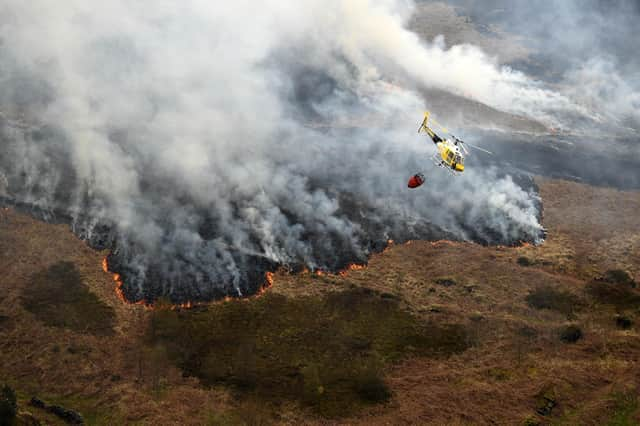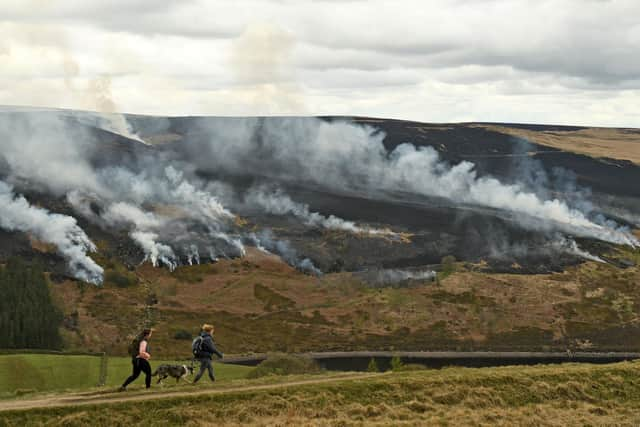Marsden Moor peat soils could take thousands of years to recover from blaze started by firecracker


A new report by the organisation has highlighted how the areas it cares for have been affected by the weather during 2021.
The report cites the major fire on Marsden Moor in West Yorkshire during one of the driest Aprils on record earlier this year.
Advertisement
Hide AdAdvertisement
Hide AdIt was started by a man letting off a firecracker but the dry conditions saw the fire burn for three days and destroy two square miles of moorland habitat.


The Trust said the area lost a diverse range of plants; species such as the golden plover, short-eared owl and mountain hare were affected and important peat soils were destroyed.
The report said the peat soils, which store carbon and are important in the battle against climate change, “will take hundreds if not thousands of years to recover”.
It also highlighted that late frosts that continued into May saw Nunnington Hall in North Yorkshire go onto record its worst apple crop for 20 years.
Advertisement
Hide AdAdvertisement
Hide AdBut the report also states that changing conditions has resulted in “winners”, as well as losers, with Hardcastle Crags in West Yorkshire recording an abundance of coral fungi including new discoveries not previously seen in the area.
The National Trust highlighted that warmer, wetter winters are resulting in diseases like ash dieback taking hold more frequently. The Trust has announced this month it needs to fell at least 30,000 trees across its estates that have been affected by ash dieback.
Meanwhile, Storm Arwen recently caused massive damage across the country, with over half of the 250-year-old oak and beech trees uprooted at Wallington in Northumberland and similar damage caused in the Lake District and Wales.
Ben McCarthy, Head of Nature Conservation and Restoration Ecology at the National Trust says: “Climate change is making some forms of extreme weather events the new normal.
Advertisement
Hide AdAdvertisement
Hide Ad“Heatwaves and heavy rainfall are becoming more frequent and more intense. What we’re seeing in the UK with the impacts of wildfires and severe storms such as Arwen and Barra, is how climate change is altering our landscapes forever.
“These dramatic incidents reflect what is going on elsewhere in the world, with extreme temperatures of over 50 degrees Celsius in California resulting in the state’s largest wildfire burning 390,000 hectares of land and extreme rainfall in China of 201.9mm in an hour resulting in devastating flash floods.
“These extreme events are putting even more pressure on Britain’s wildlife, which is already in trouble with more than half of species in decline and 15 per cent of wildlife species under threat of extinction. Our nature is part of what makes the UK unique and we must all play our part to protect it.
“The scale of the challenge we face is huge, but there is much we can do to heal climate harm. Isolated or small populations are the most at risk from climate impacts. Our conservation work protects and restores wildlife in our precious landscapes to help nature literally weather the storms. By conserving nature and improving habitats we can support larger populations that are better able to respond to the drivers of change and help nature’s survival.”
Butterflies on the move north
Advertisement
Hide AdAdvertisement
Hide AdGatekeeper butterflies, usually found in warmer south eastern counties, were spotted during annual wildlife surveys at Nostell Priory this year. Rangers recorded an increased number of the orange-winged species, which is typically abundant in the south but a rarer sight in northern areas.
Nostell ranger Richard Farrah said: “In previous years we haven’t seen many Gatekeepers at Nostell, but it appears they’re increasing in number. This suggests the species is coping well in the Wakefield climate and beginning to breed. Nostell used to be around the geographical limit of where you could regularly spot this particular butterfly and even last year, we only recorded one sighting as part of the 2020 survey.
"To know we’ve just tipped into double figures this year is a positive sign for the species.”
Read more:
Advertisement
Hide AdAdvertisement
Hide AdSupport The Yorkshire Post and become a subscriber today. Your subscription will help us to continue to bring quality news to the people of Yorkshire. In return, you'll see fewer ads on site, get free access to our app and receive exclusive members-only offers. Click here to subscribe.